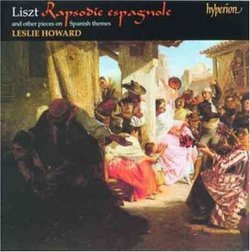| All Artists: Franz Liszt, Leslie Howard Title: Liszt: Rapsodie espagnole, and Other Pieces on Spanish Themes Members Wishing: 1 Total Copies: 0 Label: Hyperion UK Release Date: 7/8/1997 Album Type: Import Genres: Dance & Electronic, Classical Styles: Chamber Music, Forms & Genres, Fantasies, Requiems, Elegies & Tombeau, Rondos, Short Forms, Historical Periods, Classical (c.1770-1830) Number of Discs: 1 SwapaCD Credits: 1 UPC: 034571171456 |
Search - Franz Liszt, Leslie Howard :: Liszt: Rapsodie espagnole, and Other Pieces on Spanish Themes
 | Franz Liszt, Leslie Howard Liszt: Rapsodie espagnole, and Other Pieces on Spanish Themes Genres: Dance & Electronic, Classical
|
Larger Image |
CD Details |
CD ReviewsLiszt the Exoticist Hexameron | 08/30/2006 (5 out of 5 stars) "Before Bizet, Moszkowski or Lalo started integrating Spanish elements into their compositions, Liszt had already created a substantial corpus of Spanish-inspired piano pieces. He visited Spain in 1844 during his pan-European tour and wrote concert works incorporating Spanish melodies and rhythms. One particular work, the "Spanish Rhapsody," became immensely popular after Liszt's death. Other Spanish-tinged compositions remained unpublished and, according to Howard, unplayed during Liszt's life. Thankfully, Howard resurrects these exotic pieces, which are generally exquisite and unjustly ignored.
Composed in 1845, the "Grand Concert Fantasy Upon Spanish Themes" is an ample (19-minute) and striking piece. The themes, namely a fandango, jota aragonesa and cachuca are tuneful and the variations entertaining. The fantasy displays Liszt's propensity for virtuosic ear-candy, but the inventive variations and embellishments are musically satisfying. Liszt's two versions of "La romanesca," a Spanish dance tune, are not that noticeably different, although the first version is about 20 seconds longer with an alternate coda. The composition as a whole is excellent: virtuosic splash is absent and Liszt writes beautifully seductive variations oozing with exoticism; Liszt even evokes the sound of the guitar. The "Spanish Rhapsody," now a warhorse, has become as famous as the Hungarian Rhapsodies. However, some performers tend to bring an extravagantly rhapsodic approach to this piece, which Howard believes "needs a certain elegant detachment in performance" instead. Some have criticized the "Spanish Rhapsody" for its sparkles, trills, and lavish technical effects. But Howard emphasizes the underlying dramatic and melodic potential rather than the excessive decorations of the work. Howard is unsure about the origins of Liszt's "Elegy after Soriano." He suspects a Spanish zarzuela provided Liszt with material and that Liszt must have met Mariano Soriano Piqueras, an obscure Spanish composer. Liszt's "Elegy" opens with an impressively somber and gloomy introduction. But the composition unfurls like a paraphrase with constantly evolving moods: melancholy, anger, and introspection. The "Rondeau fantastique" is the earliest work to appear on this program, having been published in 1837. It is essentially a paraphrase of one number from Manuel Garcia's light opera, "Yo que soy contrabandista." Like any of Liszt's operatic paraphrases, this one is an endearing romp overflowing with attractive ideas, virtuosic flights of fancy, and even radical dissonances. For so youthful a work, Liszt explores some bizarre harmonic changes. I cannot say if they are more indicative of the exotic Spanish melodies rather than Liszt's own experimentation. Bottom line: Any Liszt aficionado unfamiliar with these Spanish-flavored pieces should immediately procure this Hyperion volume. Other non-Liszt fans would still benefit from sampling these appealing gems, especially "La romanesca" and the "Elegy after Soriano."" |

 Track Listings (6) - Disc #1
Track Listings (6) - Disc #1